浅谈隐喻认知以及隐喻翻译
- 格式:docx
- 大小:12.52 KB
- 文档页数:4
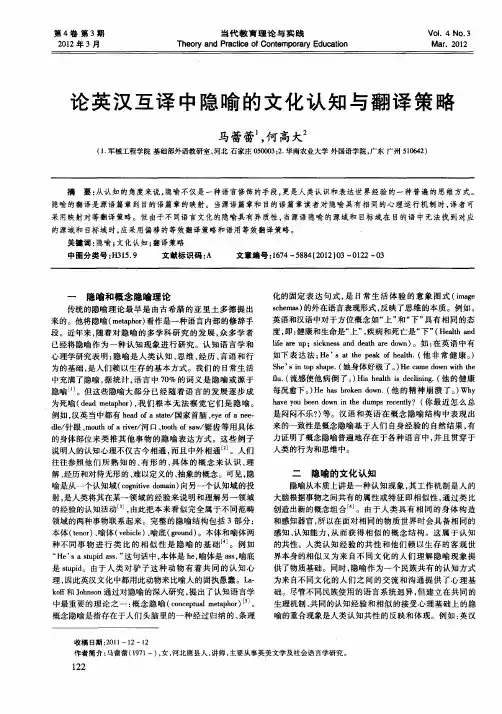
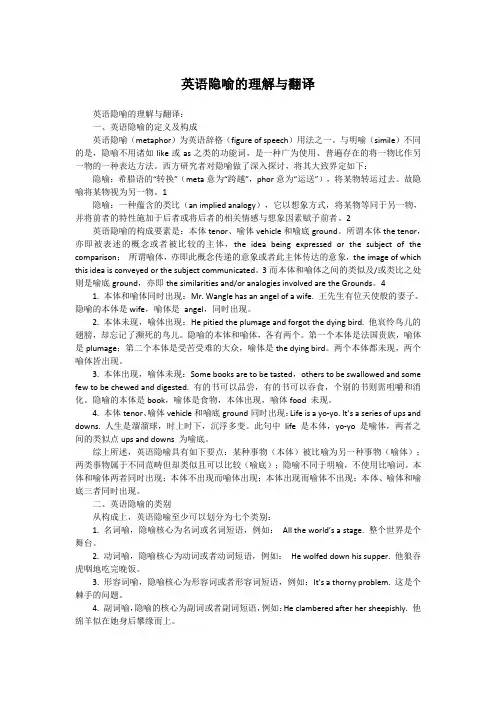
英语隐喻的理解与翻译英语隐喻的理解与翻译:一、英语隐喻的定义及构成英语隐喻(metaphor)为英语辞格(figure of speech)用法之一。
与明喻(simile)不同的是,隐喻不用诸如like或as之类的功能词,是一种广为使用、普遍存在的将一物比作另一物的一种表达方法。
西方研究者对隐喻做了深入探讨,将其大致界定如下:隐喻:希腊语的“转换”(meta意为“跨越”,phor意为“运送”),将某物转运过去。
故隐喻将某物视为另一物。
1隐喻:一种蕴含的类比(an implied analogy),它以想象方式,将某物等同于另一物,并将前者的特性施加于后者或将后者的相关情感与想象因素赋予前者。
2英语隐喻的构成要素是:本体tenor、喻体vehicle和喻底ground。
所谓本体the tenor,亦即被表述的概念或者被比较的主体,the idea being expressed or the subject of the comparison;所谓喻体,亦即此概念传递的意象或者此主体传达的意象,the image of which this idea is conveyed or the subject communicated。
3而本体和喻体之间的类似及/或类比之处则是喻底ground,亦即the similarities and/or analogies involved are the Grounds。
41. 本体和喻体同时出现:Mr. Wangle has an angel of a wife. 王先生有位天使般的妻子。
隐喻的本体是wife,喻体是angel,同时出现。
2. 本体未现,喻体出现:He pitied the plumage and forgot the dying bird. 他哀怜鸟儿的翅膀,却忘记了濒死的鸟儿。
隐喻的本体和喻体,各有两个。
第一个本体是法国贵族,喻体是plumage;第二个本体是受苦受难的大众,喻体是the dying bird。
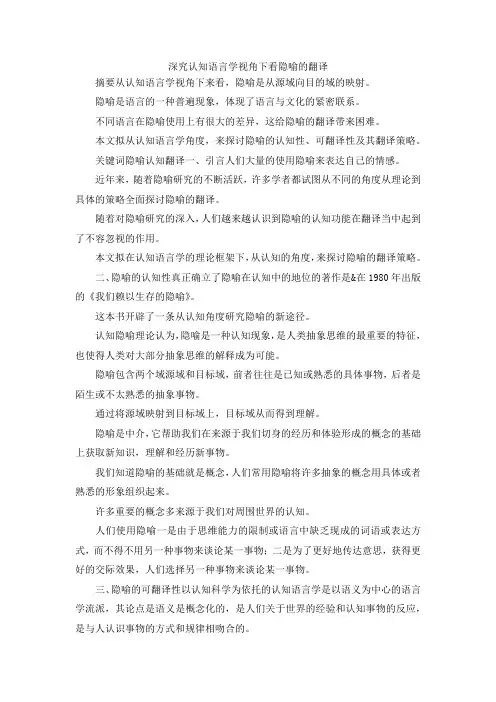
深究认知语言学视角下看隐喻的翻译摘要从认知语言学视角下来看,隐喻是从源域向目的域的映射。
隐喻是语言的一种普遍现象,体现了语言与文化的紧密联系。
不同语言在隐喻使用上有很大的差异,这给隐喻的翻译带来困难。
本文拟从认知语言学角度,来探讨隐喻的认知性、可翻译性及其翻译策略。
关键词隐喻认知翻译一、引言人们大量的使用隐喻来表达自己的情感。
近年来,随着隐喻研究的不断活跃,许多学者都试图从不同的角度从理论到具体的策略全面探讨隐喻的翻译。
随着对隐喻研究的深入,人们越来越认识到隐喻的认知功能在翻译当中起到了不容忽视的作用。
本文拟在认知语言学的理论框架下,从认知的角度,来探讨隐喻的翻译策略。
二、隐喻的认知性真正确立了隐喻在认知中的地位的著作是&在1980年出版的《我们赖以生存的隐喻》。
这本书开辟了一条从认知角度研究隐喻的新途径。
认知隐喻理论认为,隐喻是一种认知现象,是人类抽象思维的最重要的特征,也使得人类对大部分抽象思维的解释成为可能。
隐喻包含两个域源域和目标域,前者往往是已知或熟悉的具体事物,后者是陌生或不太熟悉的抽象事物。
通过将源域映射到目标域上,目标域从而得到理解。
隐喻是中介,它帮助我们在来源于我们切身的经历和体验形成的概念的基础上获取新知识,理解和经历新事物。
我们知道隐喻的基础就是概念,人们常用隐喻将许多抽象的概念用具体或者熟悉的形象组织起来。
许多重要的概念多来源于我们对周围世界的认知。
人们使用隐喻一是由于思维能力的限制或语言中缺乏现成的词语或表达方式,而不得不用另一种事物来谈论某一事物;二是为了更好地传达意思,获得更好的交际效果,人们选择另一种事物来谈论某一事物。
三、隐喻的可翻译性以认知科学为依托的认知语言学是以语义为中心的语言学流派,其论点是语义是概念化的,是人们关于世界的经验和认知事物的反应,是与人认识事物的方式和规律相吻合的。
认知语言学强调经验和认知对语言产生的重要作用,认为语言是客观现实、社会文化、生理基础和认知能力的产物,包括隐喻语言在内的任何语言现象都是有理有据的,即可以从人们的心理和认知的角度加以分析和解释。
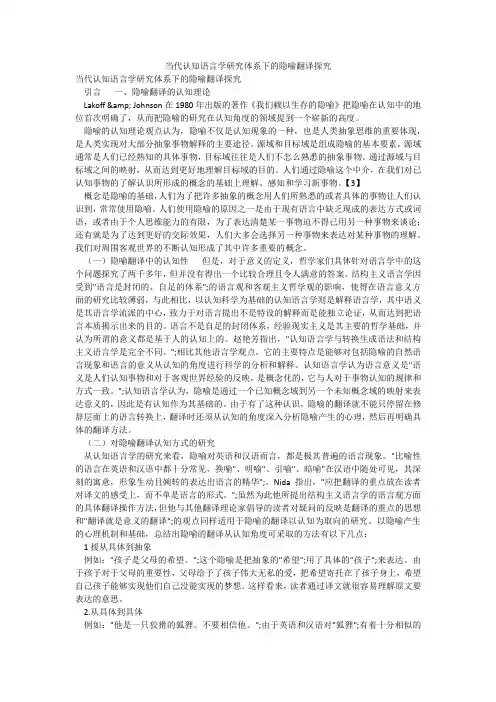
当代认知语言学研究体系下的隐喻翻译探究当代认知语言学研究体系下的隐喻翻译探究引言一、隐喻翻译的认知理论Lakoff & Johnson在1980年出版的著作《我们赖以生存的隐喻》把隐喻在认知中的地位首次明确了,从而把隐喻的研究在认知角度的领域提到一个崭新的高度。
隐喻的认知理论观点认为,隐喻不仅是认知现象的一种,也是人类抽象思维的重要体现,是人类实现对大部分抽象事物解释的主要途径。
源域和目标域是组成隐喻的基本要素,源域通常是人们已经熟知的具体事物,目标域往往是人们不怎么熟悉的抽象事物。
通过源域与目标域之间的映射,从而达到更好地理解目标域的目的。
人们通过隐喻这个中介,在我们对已认知事物的了解认识所形成的概念的基础上理解、感知和学习新事物。
【3】概念是隐喻的基础,人们为了把许多抽象的概念用人们所熟悉的或者具体的事物让人们认识到,常常使用隐喻。
人们使用隐喻的原因之一是由于现有语言中缺乏现成的表达方式或词语,或者由于个人思维能力的有限,为了表达清楚某一事物迫不得已用另一种事物来谈论;还有就是为了达到更好的交际效果,人们大多会选择另一种事物来表达对某种事物的理解。
我们对周围客观世界的不断认知形成了其中许多重要的概念。
(一)隐喻翻译中的认知性但是,对于意义的定义,哲学家们具体针对语言学中的这个问题探究了两千多年,但并没有得出一个比较合理且令人满意的答案。
结构主义语言学因受到"语言是封闭的、自足的体系";的语言观和客观主义哲学观的影响,使得在语言意义方面的研究比较薄弱,与此相比,以认知科学为基础的认知语言学则是解释语言学,其中语义是其语言学流派的中心,致力于对语言提出不是特设的解释而是能独立论证,从而达到把语言本质揭示出来的目的。
语言不是自足的封闭体系,经验现实主义是其主要的哲学基础,并认为所谓的意义都是基于人的认知上的。
赵艳芳指出,"认知语言学与转换生成语法和结构主义语言学是完全不同。
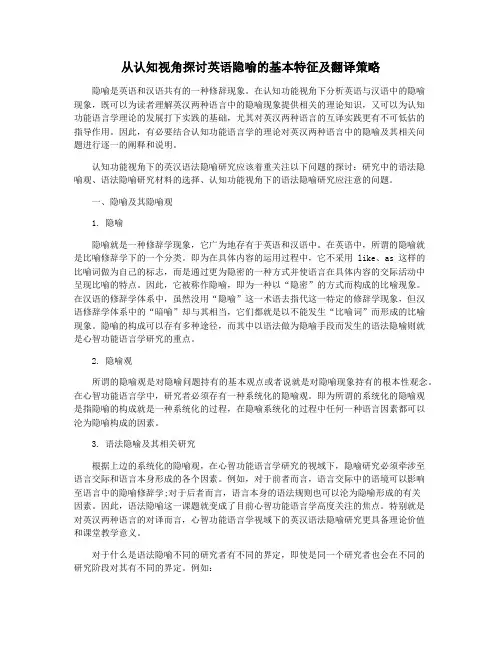
从认知视角探讨英语隐喻的基本特征及翻译策略隐喻是英语和汉语共有的一种修辞现象。
在认知功能视角下分析英语与汉语中的隐喻现象,既可以为读者理解英汉两种语言中的隐喻现象提供相关的理论知识,又可以为认知功能语言学理论的发展打下实践的基础,尤其对英汉两种语言的互译实践更有不可低估的指导作用。
因此,有必要结合认知功能语言学的理论对英汉两种语言中的隐喻及其相关问题进行逐一的阐释和说明。
认知功能视角下的英汉语法隐喻研究应该着重关注以下问题的探讨:研究中的语法隐喻观、语法隐喻研究材料的选择、认知功能视角下的语法隐喻研究应注意的问题。
一、隐喻及其隐喻观1. 隐喻隐喻就是一种修辞学现象,它广为地存有于英语和汉语中。
在英语中,所谓的隐喻就是比喻修辞学下的一个分类。
即为在具体内容的运用过程中,它不采用 like、as 这样的比喻词做为自己的标志,而是通过更为隐密的一种方式并使语言在具体内容的交际活动中呈现比喻的特点。
因此,它被称作隐喻,即为一种以“隐密”的方式而构成的比喻现象。
在汉语的修辞学体系中,虽然没用“隐喻”这一术语去指代这一特定的修辞学现象,但汉语修辞学体系中的“暗喻”却与其相当,它们都就是以不能发生“比喻词”而形成的比喻现象。
隐喻的构成可以存有多种途径,而其中以语法做为隐喻手段而发生的语法隐喻则就是心智功能语言学研究的重点。
2. 隐喻观所谓的隐喻观是对隐喻问题持有的基本观点或者说就是对隐喻现象持有的根本性观念。
在心智功能语言学中,研究者必须存有一种系统化的隐喻观。
即为所谓的系统化的隐喻观是指隐喻的构成就是一种系统化的过程,在隐喻系统化的过程中任何一种语言因素都可以沦为隐喻构成的因素。
3. 语法隐喻及其相关研究根据上边的系统化的隐喻观,在心智功能语言学研究的视域下,隐喻研究必须牵涉至语言交际和语言本身形成的各个因素。
例如,对于前者而言,语言交际中的语境可以影响至语言中的隐喻修辞学;对于后者而言,语言本身的语法规则也可以沦为隐喻形成的有关因素。
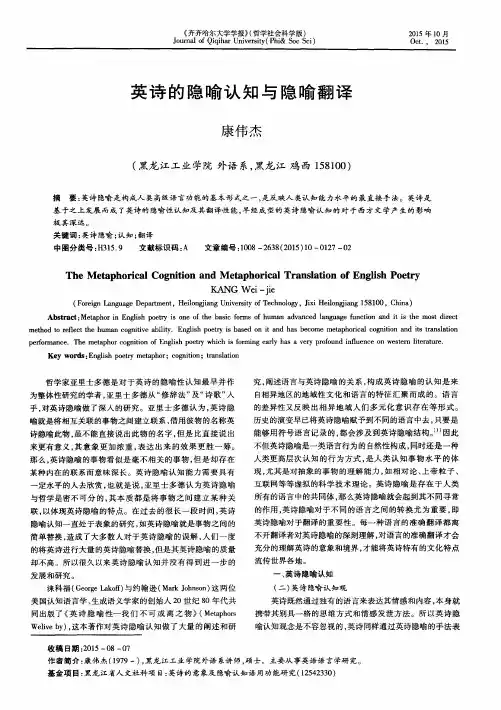
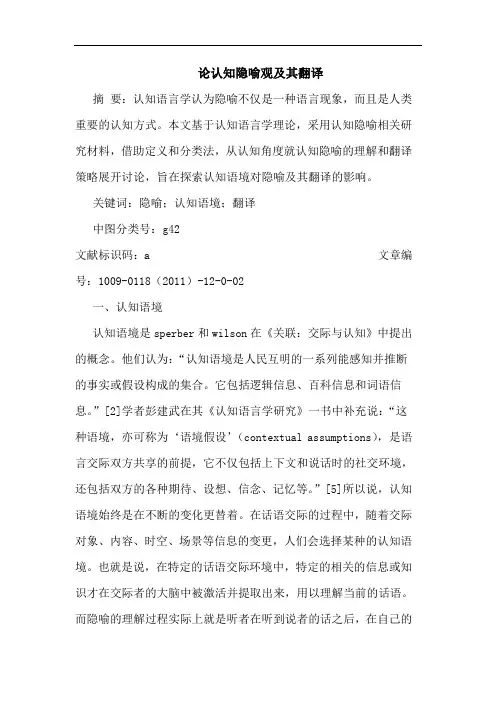
论认知隐喻观及其翻译摘要:认知语言学认为隐喻不仅是一种语言现象,而且是人类重要的认知方式。
本文基于认知语言学理论,采用认知隐喻相关研究材料,借助定义和分类法,从认知角度就认知隐喻的理解和翻译策略展开讨论,旨在探索认知语境对隐喻及其翻译的影响。
关键词:隐喻;认知语境;翻译中图分类号:g42 文献标识码:a 文章编号:1009-0118(2011)-12-0-02一、认知语境认知语境是sperber和wilson在《关联:交际与认知》中提出的概念。
他们认为:“认知语境是人民互明的一系列能感知并推断的事实或假设构成的集合。
它包括逻辑信息、百科信息和词语信息。
”[2]学者彭建武在其《认知语言学研究》一书中补充说:“这种语境,亦可称为‘语境假设’(contextual assumptions),是语言交际双方共享的前提,它不仅包括上下文和说话时的社交环境,还包括双方的各种期待、设想、信念、记忆等。
”[5]所以说,认知语境始终是在不断的变化更替着。
在话语交际的过程中,随着交际对象、内容、时空、场景等信息的变更,人们会选择某种的认知语境。
也就是说,在特定的话语交际环境中,特定的相关的信息或知识才在交际者的大脑中被激活并提取出来,用以理解当前的话语。
而隐喻的理解过程实际上就是听者在听到说者的话之后,在自己的认知语境中选择出与说者的交际意图相关联的信息或假设,从而推导出说者真正的信息意图。
也就是说隐喻的理解过程最重要的就是认知语境的选定过程。
[3]二、认知隐喻观正因为有了认知语境的变化和选择,对隐喻的认识也不再停留在表层概念,而深入到认知体系。
在认知学界,从认知角度对隐喻的理解和定义被称为隐喻的认知观。
很多当代认知学家对此持有大相径庭的观点,其中,lakoff和johnson的《我们赖以生存的隐喻》对隐喻认知观作出了系统全面的阐述,其基本观点为:人类语言整体上是一个隐喻性的符号系统,语言使用中的隐喻只是一种表层现象,真正起作用的是深藏在我们概念系统中的隐喻概念。
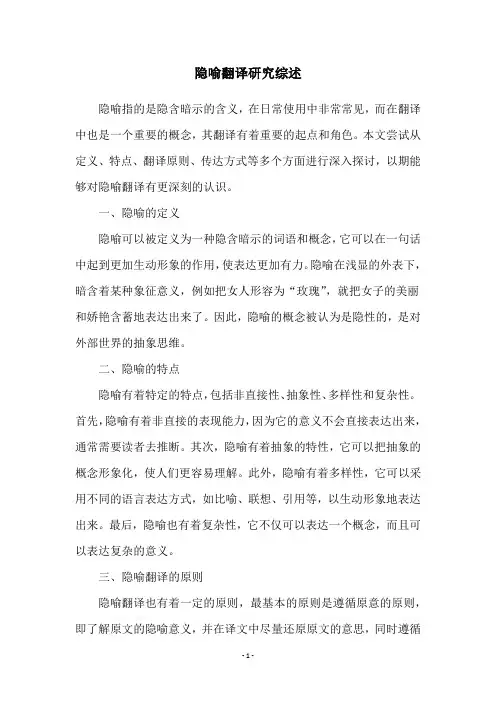
隐喻翻译研究综述隐喻指的是隐含暗示的含义,在日常使用中非常常见,而在翻译中也是一个重要的概念,其翻译有着重要的起点和角色。
本文尝试从定义、特点、翻译原则、传达方式等多个方面进行深入探讨,以期能够对隐喻翻译有更深刻的认识。
一、隐喻的定义隐喻可以被定义为一种隐含暗示的词语和概念,它可以在一句话中起到更加生动形象的作用,使表达更加有力。
隐喻在浅显的外表下,暗含着某种象征意义,例如把女人形容为“玫瑰”,就把女子的美丽和娇艳含蓄地表达出来了。
因此,隐喻的概念被认为是隐性的,是对外部世界的抽象思维。
二、隐喻的特点隐喻有着特定的特点,包括非直接性、抽象性、多样性和复杂性。
首先,隐喻有着非直接的表现能力,因为它的意义不会直接表达出来,通常需要读者去推断。
其次,隐喻有着抽象的特性,它可以把抽象的概念形象化,使人们更容易理解。
此外,隐喻有着多样性,它可以采用不同的语言表达方式,如比喻、联想、引用等,以生动形象地表达出来。
最后,隐喻也有着复杂性,它不仅可以表达一个概念,而且可以表达复杂的意义。
三、隐喻翻译的原则隐喻翻译也有着一定的原则,最基本的原则是遵循原意的原则,即了解原文的隐喻意义,并在译文中尽量还原原文的意思,同时遵循译语文化的特点,以免形成文化冲突。
另外,也要尊重源文意义,不要改变文字的意思或含义,以免丢失源语的气氛。
此外,隐喻翻译也要有趣,尽量使译文有趣耐读,而不要翻译成冷板板的白话文。
最后,隐喻的翻译应该是合理的,翻译完必须要能够被读者理解,而不是空洞的语句。
四、传达隐喻的方法传达隐喻的方法有很多,可以按照语言的不同而进行分类。
最常用的方法是比喻,它是把一个抽象的概念用一种具体的形象概括出来,例如“人民就是财富的源泉”,用“源泉”比喻“人民”,表达了人民是财富的来源。
另外,还可以使用联想的方法,把一个抽象的概念用一种联想的方式表达出来,比如“精神长存”,即把长期的精神联想到“长存”来表达出来。
五、结论隐喻在日常使用中非常常见,而在翻译中也是一个重要的概念,其翻译有着重要的起点和角色。
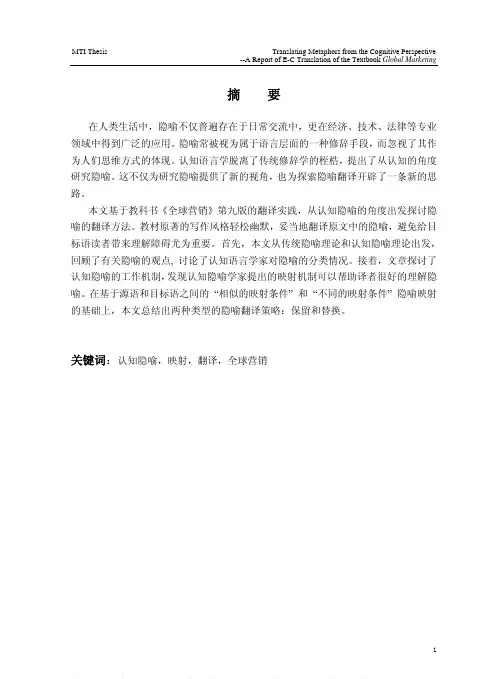
MTI Thesis Translating Metaphors from the Cognitive Perspective --A Report of E-C Translation of the Textbook Global Marketingi摘 要在人类生活中,隐喻不仅普遍存在于日常交流中,更在经济、技术、法律等专业领域中得到广泛的应用。
隐喻常被视为属于语言层面的一种修辞手段,而忽视了其作为人们思维方式的体现。
认知语言学脱离了传统修辞学的桎梏,提出了从认知的角度研究隐喻。
这不仅为研究隐喻提供了新的视角,也为探索隐喻翻译开辟了一条新的思路。
本文基于教科书《全球营销》第九版的翻译实践,从认知隐喻的角度出发探讨隐喻的翻译方法。
教材原著的写作风格轻松幽默,妥当地翻译原文中的隐喻,避免给目标语读者带来理解障碍尤为重要。
首先,本文从传统隐喻理论和认知隐喻理论出发,回顾了有关隐喻的观点, 讨论了认知语言学家对隐喻的分类情况。
接着,文章探讨了认知隐喻的工作机制,发现认知隐喻学家提出的映射机制可以帮助译者很好的理解隐喻。
在基于源语和目标语之间的 “相似的映射条件” 和 “不同的映射条件” 隐喻映射的基础上,本文总结出两种类型的隐喻翻译策略:保留和替换。
关键词:认知隐喻,映射,翻译,市场营销 认知隐喻,映射,翻译,全球营销Abstract MTI ThesisiiAbstractIn everyday life, metaphors not only exist in daily communication but also are appliedwidely in the professional fields, including economy, technology, law and etc. Metaphors are always viewed as a kind of rhetorical device, which is confined to the language field. People tend to ignore that metaphors can also reflect the way of thinking. Free of the traditional rhetoric’s constraints, cognitive linguistics put forward to study the metaphor from the cognitive perspective. This not only provides a new angle to study metaphors but also works out a new way to do research on metaphor translation.Based on the translation practice on the textbook, Global Marketing (9th Edition), this report explores the metaphor translation from the cognitive perspective. As the textbook is written with great humor and ease, it is vital to deal with the metaphor translation properly so as to facilitate target readers’ understanding. Firstly, this report reviews the traditional and cognitive views on metaphors respectively and discusses the classification of metaphors based on the cognitive linguists’ views. Then, this report explores the working mechanism of cognitive metaphors and finds out the mapping system of cognitive metaphors can facilitate translators’ understanding of metaphors. Based on the “similar mapping conditions” and “different mapping conditions”, this report summarizes two translation strategies, which are retaining and replacing.Key words: c ognitive metaphor, mapping, translation, global marketingMTI Thesis Translating Metaphors from the Cognitive Perspective --A Report of E-C Translation of the Textbook Global MarketingTable of Contents摘要 (i)Abstract (ii)Chapter One Introduction (1)1.1 Research Background (1)1.2 Research Significance (1)1.3 Structure of the Report (2)Chapter Two Task Description (3)2.1 Background of the Translation Task (3)2.2 Characteristics of the Source Text (4)Chapter Three Literature Review (5)3.1 Traditional Views of Metaphors (5)3.2 Cognitive Views of Metaphors (6)3.2.1 Image-schema Metaphors (8)3.2.2 One-shot Image Metaphors (9)3.3 Metaphor Translation in Translation Theories (10)3.3.1 Metaphor Translation in Traditional Translation Theories (10)3.3.2 Translating Metaphors under the Guidance of Cognitive Linguistics (12)Chapter Four Case Analysis (14)4.1 Cognitive Processes of Metaphor Translation (14)4.2 Image-schema Metaphor Translation (15)4.2.1 Retaining image-schema metaphors in TL (15)4.2.2 Replacing image-schema metaphors in TL (18)4.3 One-shot Image Metaphor Translation (20)4.3.1 Retaining one-shot image metaphors in TL (20)4.3.2 Replacing one-shot image metaphors in TL (22)Chapter Five Conclusion (25)5.1 Major Findings (25)5.2 Limitations (26)Acknowledgements (27)References (28)iiiAbstract MTI Thesis Appendix I (30)ivList of Figures3.1 Working mechanism of the cognitive metaphor theory (7)4.1 Translation processes raised by Nida and Taber (12)4.2 OUT schema 1 raised by Johnson (14)4.3 OUT schema 2 raised by Johnson (14)vChapter OneIntroduction1.1 Research Background“Four decades ago, the phrase global marketing, did not exist. Nowadays, companies go global to survive as competitors will enter home markets with lower costs, more experience, and better products” said by Keegan and Green (2017, p. 4). Apple Inc, Procter & Gamble, General Motor, Toyota, Philips, Lenovo, Huawei, and many other transnational companies are playing more and more important roles in the global market as well as in people’s daily life. The Chinese government also launches new policies to encourage domestic enterprises to go globally. It is important to introduce the latest business knowledge into China and know how the market is operated globally.Launching a higher standard on textbook translation is critical for it is one of the major resources of knowledge input. Global Marketing provides a critical awareness of the principal concepts, frameworks, and techniques of international marketing and have achieved success worldwide. The first edition of this textbook was published in September 1996 and achieved immediate success. Now, it comes to the newest version, the ninth edition, which was published in 2016 and marked its 20th anniversary as well. This textbook was translated into a variety of languages and regarded as a classical reading.1.2 Research SignificanceThe original textbook was written with great humor and ease and used various metaphors to facilitate readers understanding of abstract, shapeless concepts through transferring them into familiar, concrete, tangible concepts which are directly grounded in people’s experience. This highlights the importance of translating the metaphors in the textbook. However, the translation work of this textbook is far more behind. There is no available Chinses version of the textbook, Global Marketing (9th Edition), in the market.1Chapter One Introduction MTI ThesisThe only available translated copies of this textbook are the 4th edition and the 6th edition, whose original English version was published in 2005 and 2010 respectively. To keep pace with the swift development of the economy and volatile marketing environment, the 9th edition has been updated and added various new marketing cases and strategies. Therefore, there is a need to translate the latest one, 9th edition, so as to bring the newest marketing knowledge into China.1.3 Structure of the ReportThis report discusses the metaphor translation from the cognitive perspective and includes five chapters. The first chapter gives an introduction to the background and significance of the research. Chapter two is composed of the background of the translation task and the characteristics of the source text. Chapter three is made up of the literature review on the traditional and cognitive views on the metaphors as well as translation theories on the metaphors. Chapter four discusses the translation processes on cognitive metaphors and applies the processes into the case analysis. Specific examples are extracted from the translation materials to explore the metaphor translation through the cognitive perspective. Chapter five summarizes the major findings and points out the limitations of this report.2MTI Thesis Translating Metaphors from the Cognitive Perspective --A Report of E-C Translation of the Textbook Global MarketingChapter TwoTask Description2.1 Background of the Translation TaskGlobal Marketing was written by Prof. Keegan and Prof. Green in English. This textbook has been adopted at scores of universities and translated into different languages, such as Japanese, Arabic, Korean, Chinese, Spanish and Italian. The 9th edition, building on the worldwide success of the previous editions, is the latest version and marks its 20th anniversary as well.Currently, the latest and only available Chinese copy of this textbook in the market is the 6th edition, while its English version was published as early as 2006. To supply up-to-date insights into the complex shifts in the global market, the 9th edition has updated and revised almost fifty percentage of the chapters, such as opening vignettes, end-of-chapter cases, all the data in the tables. It is clear to see the translation work is far more behind. Meanwhile, as textbook translation is one of the major resources of knowledge input, there is a need to translate the latest version so as to keep pace with the swift changes around the world.Besides, the previous Chinese version is obscure and contains heavy translationese to some extent. What’s worse, it also has obvious translation mistakes, e.g. “unparalleled expansion into global markets” was translated into “在全球市场上实行不对称的扩张”. A proper translation can be “在全球市场上进行大规模的扩张”. Thus, the translation of this classic textbook should be treated seriously so to facilitate target readers’ understanding on the advanced global marketing knowledge .3Chapter Two Task Description MTI Thesis 2.2 Characteristics of the Source TextThe source text takes an environmental and strategic approach by outlining the major dimensions of the global business environment. It is authoritative in content yet relaxed and assured in style and tone. The textbook contains scores of real-life examples as well as metaphorical expressions to illustrate vividly the dynamic, integrated nature of the global market.Metaphors are reflected in this textbook by a wide variety of expressions : “low quality”, “ top managers”, “turn sour on global sales”, “horn of plenty”, “shove cars into consumer’s throat” and etc. People may get used to some of these words and won’t regard them as metaphorical expressions. That’s because “people’s conventional ways of talking about things pre-suppose a metaphor people are hardly ever conscious of” (Lakoff & Johnson, 1980, p. 5). For example, “low quality” and “top managers” are based on people’s physical experience and then associate abstract ideas that do not really have a location with a particular place in the space (1980, p. 14). In this way, certain abstract ideas are linked to others, which can facilitate the understanding on abstract concepts. However, different languages and culture may conceptualize things metaphorically in different ways. These require translators should deal with metaphors cautiously and properly as well as try the best to retain the humorous tone of the original English copy.4MTI Thesis Translating Metaphors from the Cognitive Perspective --A Report of E-C Translation of the Textbook Global MarketingChapter ThreeLiterature Review3.1 Traditional Views of MetaphorsAlthough the studies on metaphors have been centuries, it is the traditional views ofmetaphors that dominate the study on metaphors before the presence of other academic schools are known. Traditional views regard metaphors as “the characteristic of language alone” and “a property of words rather than thought or action” (Lakoff and Johnson, 1980, p. 8). Traditional views are mainly composed of three major theories, which are “comparison theory” (raised by Aristotle), “substitution theory” (Quintilian), and “interaction theory” (Richards).The study on metaphors is first raised by Aristotle, a great philosopher in Greeks, who defines metaphor as “metaphor consists in giving the thing a name that belongs to something else; the transference being either from genus to species, or from species to genus, or from species to species, or on grounds of analogy” (Aristotle, 1954, pp. 6-9). Aristotle points out that metaphor is based on analogy. He also speaks highly of using metaphors and mentions “greatest thing, by far, was to be a master of metaphor” (Aristotle, 1954,p. 2). The biggest contribution that Aristotle makes is that he demonstrates the nature of metaphor is the transference of meaning. But he restricts metaphorical transference is taken place at the level of words rather than sentences (Ricoeur, 1977).Quintilian, a Roman rhetorician, proposes the theory of substitution firstly in the first century and reveals that metaphor is essentially a sort of rhetoric, which “substitutes another word for one word” (Quintilian, 1907). He appraises metaphors as “the commonest and most beautiful of tropes... For if it is correctly and appropriately applied, it is quite impossible for its effect to be commonplace, mean or unpleasing. It adds to the copiousness of language by the interchange of words and by borrowing and finally succeeds in the supremely difficult task of providing a name for everything” (Quintilian,1907, pp. 4-7). Both Aristotle and Quintilian considers metaphor is ornamental and5decorative in nature and was a deviation of normal language in its structure and form (Shu, 2000, p. 3).I.A. Richards is acknowledged to be the originator of the interaction theory. In the 1930s, Richards (1936) explains the principle of metaphor in his book, The philosophy of rhetoric, as “when we use a metaphor we have two thoughts of different things active together and supported by a single word, or phrase, whose meaning is a resultant of their interaction.” Interaction theory of metaphor is further developed by Max Black, who explains “the working of metaphor as an interplay between its focus and its frame” (Black, 1962). Black also argues that the frame of the metaphor “imposes extensions of meaning upon the focal word” (1962). To clarify how the two thoughts interacts together, Black regards “the two components of a metaphor as systems, rather than isolated words or phrases” and systems contains “the general knowledge and beliefs about their subject matter” (“associated commonplaces”) (Black, 1962). Then a filter metaphor is used by Black to explain “how the associated commonplaces of the subsidiary subject (indicated by the focus of the metaphor) organize the principal subject (indicated by the frame of the metaphor)” (1962).3.2 Cognitive Views of MetaphorsGeorge Lakoff and Mark Johnson reinterprets metaphors from a new perspective and found the conceptual metaphor theory (CMT). Their publication of Metaphors We Live By sets a milestone of studying metaphors from the cognitive perspective, distinguishing them from the traditional rhetorical and semantic metaphor studies. Firstly, they think metaphors are widely applied in the ordinary language rather than restricted into the literary texts. Secondly, they regard metaphors as a matter of thought and action. Metaphors should not be viewed as language alone.Lakoff and Johnson interprets metaphor in details as “we have found, on the contrary, that metaphor is pervasive in everyday life, not just in language but in thought and action. Our ordinary conceptual system, in terms of which we both think and act, is fundamentally metaphorical in nature” (1980, p. 8). In terms of the essence of metaphor, Lakoff and--A Report of E-C Translation of the Textbook Global Marketing Johnson point out “metaphor is understanding and experiencing one kind of thing in terms of another” and “a cross-domain mapping in the conceptual system” (1980, p. 5). Kovecses also claims: “when one conceptual domain is understood in terms of another conceptual domain, we have a conceptual metaphor” (2002, p. 48).The working mechanism of cognitive metaphor theory is the mapping across domains (Figure 3.1). Source domain is “the conceptual domain from which people draw metaphorical expressions” (Kovecses, 2002, p. 6). Target domain is “what people try to understand” (Kovecses, 2002, p. 6). This cognitive system can facilitate people’s understanding of abstract, shapeless concepts through transferring them into familiar, concrete, tangible concepts which are directly grounded people’s experience (Kovecses, 2002, p. 48).Figure 3.1: Working mechanism of the cognitive metaphor theoryTo illustrate the working mechanism of cognitive metaphor theory, this report cites one example from Johnson’s the Contemporary Theory of Metaphor. A love relationship can be described by a cognitive metaphor as “our relationship has hit a dead-end street”. Here love (target domain) is being conceptualized as a journey (source domain), implying that this love relationship is stalled and the lovers have to break up or find a way to figure out the problems. Meanwhile, Lakoff also pointed out “metaphorical mappings may vary in universality; some seem to be universal, others are widespread, and some seem to be culture-specific” (1993). This will add difficulties to convert the metaphors from source language (SL) to the target language (TL).Kovecses classifies the cognitive metaphors into image-schema metaphors and one-shot image metaphors. Ye Zinan also points out many scholars have the same classification as well (2013, p. 34). Based on this classification, this report will make ananalysis of cognitive metaphors from image-schema metaphors and one-shot image metaphors.3.2.1 Image-schema MetaphorsJohnson defines image schema as “the pervasive act of metaphorically extending a schema from the physical to the nonphysical”, “a means of structuring particular experiences schematically, so as to give order and connectedness to our perceptions and conceptions” and “image schema (schemata) are those recurring structures of, or in, our perceptual interactions, bodily experiences, and cognitive operations” (Johnson, 1987, pp. 34-79). Kovecses says “images that have extremely general schematic structure are called image-schemas. Image-schemas of various sorts, such as the container or force schemas, structure many abstract concepts metaphorically (2000, p. 40). Meanwhile, Johnson also explains that schemata were not diagrams on a page nor particular images. To experience the connected and unfiled world, there must be a repeatable pattern, schemata.To illustrate the image-schema metaphors, this report cited three examples from the books of Lakoff and Johnson as well as of Kovecses:Example 1: I'm feeling up. My spirits rose. I'm feeling down. My spirits sank (Lakoff & Johnson, 1980, p. 15).Analysis: Example 1 coveys the UP-DOWN schema. This is based on people’s physical experience on spatial orientation. Dropping posture is always associated with sadness and depression. While, erect posture manifests a positive emotional state (Lakoff & Johnson, 1980, p. 15).Example 2: He's in love. He's coming out of the coma (Lakoff & Johnson, 1980, p.32).Analysis: Example 2 is the CONTAINER (IN-OUT) schemas. The states of love and coma are conceptualized as containers. The physical basis is that people get so used to projecting their own in-out orientation onto other physical objects that are bounded by surfaces. Even where there is no physical bounding surface, people can still “make off--A Report of E-C Translation of the Textbook Global Marketing territory so that it has an inside and a bounding surface” (Lakoff & Johnson, 1980, pp. 29-30).Example 3: the heart of the problem; the head of the department (Kovecses, 2000, p.16).Analysis: Example 3 utilizes the human body as the source domain to illustrate the abstract target domain metaphorically. The physical basis is that “both heart and head are rather important organs for the human being. They are used to describe the key part of the problem and the importance of the department respectively”(Kovecses, 2000, p. 16).Scholars have various classifications on image schemas, owing to the different emphasis on the definition. Johnson lists twenty-seven image schemas, namely “container, iteration, near-far, scale, balance, enablement, attraction, cycle, blockage, process, path, center, object, part-whole, merging, counterforce, contact, compulsion, mass-count, restraint removal, link, surface, splitting, full-empty, matching, superimposition, and collection” (Johnson, 1987). Talmy proposes four key schematic systems, which are “the configurational system, the perspectival system, attentional system, and the force-dynamic system” (Talmy, 2000). Croft and Cruse mention seven kinds of image schema metaphors: “container, scale, whole, force, match, space and exist” (Croft & Cruse,2004).3.2.2 One-shot Image MetaphorsKovecses points out that there is also a group of one-shot image metaphors. These are metaphors that “images that are not based on recurrent experience with a generic structure but capture a specific experience”, “we bring into correspondence two rich images for a temporary purpose on a particular occasion”, and “involve the superimposition of one rich image onto another rich image” (2002, pp. 40-251). Lakoff claims that this kind of image metaphor maps “only one image onto other image” and “conventional mental images onto other conventional mental images by virtue of their internal structure” (1987, p. 219). In terms of the conventional images, they are acquired largely unconsciously and automatically over the years by members of a cultural community (Lakoff, 1987, p. 220).Both Lakoff and Kovecses used the example of “my wife….whose waist is an hourglass” to interpret it. This example has two detailed images: one is the body of awoman and one for an hourglass. The image of an hourglass (source domain) is used to map the body of a woman (target domain). Kovecses explains this example in detail in his book, Metaphor: A Practical Introduction, that“what is especially noteworthy is that the words themselves do not say anything about which part of the hourglass should be mapped onto which part of the woman’s body. Yet, readers can know exactly which part maps onto which on the basis of the common shape” (2002, p. 51). This makes image metaphors are conceptual as well, rather than simply linguistic.3.3 Metaphor Translation in Translation Theories3.3.1 Metaphor Translation in Traditional Translation TheoriesVarious theories and approaches have been proposed with regard to metaphor translation. Metaphor translation in traditional translation theories are based on the traditional understanding of metaphor as “a figure of speech, as a linguistic expression which is substituted for another expression (with a literal meaning), and whose main function is the stylistic embellishment of the text”(Schäffner, 2003). The main function of metaphors in traditional translation theories is the stylistic embellishment of the text.Kloepfer, Reiss, Mason and many other scholars view metaphor translation is no different than translation in general. Kloepfer claimed “all the metaphors: their famous “boldness” is no problem for the translation, on the contrary, the bolder and more creative the metaphor, the easier it is to repeat in other languages”(Snell-Hornby, 1995, p. 57). Reiss includes Kloepfer’s statement in her discussion of metaphor and points out that a novel metaphor, which has been created by the author, should be translated “wortwörtlich” ‘literally’ (Reiss, 1971, pp. 43–44). “There cannot be a theory of the translation of metaphor; there can only be a theory of translation” said by Mason (1982, p. 149).However, Nida and Dagut hold the opposite opinion that metaphors are untranslatable. Nida identifies there are vacancies and gaps between culturally defined metaphors and says “even for an obvious metaphor,e.g. Adam’s apple, it is clear that some adjustment in lexical form is inevitable, especially in regions where apples are unknown and no one has--A Report of E-C Translation of the Textbook Global Marketing ever heard of Adam. In Uduk, for example, this anatomical feature becomes ‘the thing that wants beer”(1964, p. 219). Dagut views metaphors as “individual flash of imaginative insight” and their main function were to shock readers with creating an aesthetic impact (1976, p. 22). For Dagut, metaphor is highly culture specific and the translation of metaphor should also retain this effect of shock. If this effect is damaged due to the cultural factors, Dagut views metaphors can not be translated and there is no “a single generalization about the translation of metaphor” (Dagut ,1976).Newmark (1981) claims that metaphors are translatable, but poses a considerable degree of inequivalence. With offering principles, rules and guidelines, Newmark divides metaphors into six types: dead, cliché, stock, adapted, recent and original, and represents seven metaphor translation procedures in a prescriptive way (Newmark, 2001). Van Den Broeck mentions “translatability keeps an inverse proportion with the quantity of information manifested by the metaphor and the degree to which this information is structured in a text. The less the quantity of information conveyed by a metaphor and the less complex the structural relations into which it enters in. a text, the more translatable this metaphor will be, and vice versa”(1981, p. 84). To reproduce the metaphors, Van Den Broeck uses a descriptive framework and lists three solutions: “translation sensu stricto”, “substitution” and “paraphrase”(1982, p.77).Chinese scholars have also done tremendous research on metaphor translation in various perspectives. Wei Mengfen (2011) investigates metaphors from the cultural insights and explores the effect of culture on metaphors’ translation. From the pragmatic perspective, Chen Xirong (2003) points out metaphors have the features of calculability and uncertainty in the context of culture and situation, enlightening the translation on metaphors. Based on the seven standards and four categories of textuality raised by Beaugrande and Dressler, Chen Lijiang (2003) puts forward to several methods to solve the problems while translating metaphors. After doing a thorough research on the ways of how translators handle the cultural obstacles in the metaphor translation, Li Yunxing (2001, p. 123) summarizes five models: the go-ahead model, the block model, the annotation model, the integration model as well as the adaption model.3.3.2 Translating Metaphors under the Guidance of Cognitive LinguisticsAs mentioned above, the essence of cognitive metaphor is “understanding and experiencing one kind of thing in terms of another” and “a cross-domain mapping in the conceptual system” (Lakoff & Johnson, 1980, p. 4). The working mechanism of cognitive metaphor theory is the mapping across domains. Source domain is the cognitive domain from which people draw metaphorical expressions. Target domain is the what people try to understand. As mapping is an essential part of cognitive metaphors, there is a need to explore the metaphor translation from a cognitive linguistic perspective.Cognitive approaches have been applied to translating metaphors recently and are mainly raised by Schäffner, Mandelblit, Al-Hasnawi, and Kovecses. Schäffner (2003, p. 1267) carries out corpus studies on the cognitive metaphors in political discourse and showed how translator should handle metaphorical expressions: “(1) a conceptual metaphor is identical in ST and TT at the macro-level without each individual manifestation having been accounted for at the micro-level; (2) structural components of the base conceptual schema in the ST are replaced in the TT by expressions that make entailments explicit; (3) a metaphor is more elaborate in the TT; (4) ST and TT employ different metaphorical expressions which can be combined under a more abstract conceptual metaphor; (5) the expression in the TT reflects a different aspect of the conceptual metaphor”.Mandelblit raises the “cognitive translation hypothesis” and two schemas of cognitive mapping conditions in 1995. One of the schemas is the “similar mapping condition” (SMC) and the other one is the “different mapping condition”(DMC). He also points out that “the difference in reaction time is due to a conceptual shift that the translator is required to make between the conceptual mapping systems of the source and target languages” (Mandelblit, 1995, p. 493). Thus, metaphorical expressions will take more time and are more difficult to translate if the exploited cognitive domain is different from the target language equivalent expression. Under the “similar mapping condition”, Mandelblit points out that “translators are able to get an equivalent TL metaphor or—under the worst conditions—a TL simile” (1995, p. 493). Under the “different mapping condition”, it is。

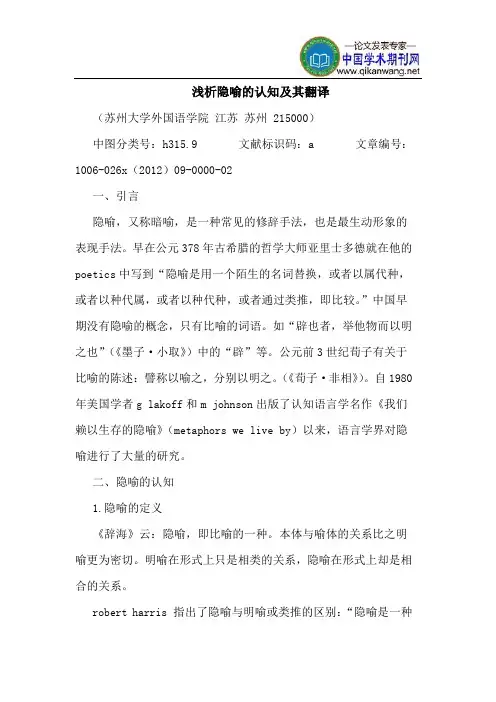
浅析隐喻的认知及其翻译(苏州大学外国语学院江苏苏州 215000)中图分类号:h315.9 文献标识码:a 文章编号:1006-026x(2012)09-0000-02一、引言隐喻,又称暗喻,是一种常见的修辞手法,也是最生动形象的表现手法。
早在公元378年古希腊的哲学大师亚里士多德就在他的poetics中写到“隐喻是用一个陌生的名词替换,或者以属代种,或者以种代属,或者以种代种,或者通过类推,即比较。
”中国早期没有隐喻的概念,只有比喻的词语。
如“辟也者,举他物而以明之也”(《墨子·小取》)中的“辟”等。
公元前3世纪荀子有关于比喻的陈述:譬称以喻之,分别以明之。
(《荀子·非相》)。
自1980年美国学者g lakoff和m johnson出版了认知语言学名作《我们赖以生存的隐喻》(metaphors we live by)以来,语言学界对隐喻进行了大量的研究。
二、隐喻的认知1.隐喻的定义《辞海》云:隐喻,即比喻的一种。
本体与喻体的关系比之明喻更为密切。
明喻在形式上只是相类的关系,隐喻在形式上却是相合的关系。
robert harris 指出了隐喻与明喻或类推的区别:“隐喻是一种比较,极具想象力地将一个事物与另一个不相似的事物认同,将后者的某些特性传送或归属于前者。
与明喻或类推不同,隐喻肯定一事物就是一事物,不是仅仅相似而已。
”(robert harris,2001)。
该定义把隐喻的词语层面提升到事物的意象层面,以事物与另一事物的认同需要想象力。
美国语言学家matthews曾把隐喻定义为:“隐喻是一种修辞格,通过它,一个通常被用于某种物体、动作的单词或表达被扩展到另一个物体或动作上。
”(matthews,r.j,1971:413-425)。
国内的许多语言学者在研究西方隐喻理论的基础上也提出了自己的隐喻观点。
从语言的阐释和修辞功能上说,隐喻“是以一个异质而同值的鱼刺置换在常规词序中应该的语词。
龙源期刊网 http://www.qikan.com.cn 浅谈教学中英语隐喻认知及翻译策略 作者:黄永媛 孙海一 来源:《群文天地》2012年第08期
摘要:中国学生总是感到隐喻翻译问题学起来比较棘手,一个主要的原因是没有很好地掌握英语隐喻包涵的文化信息。本文主要通过探讨了认知英语隐喻所涵盖的英语文化信息入手,使学生从文化的角度理解并掌握翻译的技巧及策略,提高他们的英语隐喻翻译能力。
关键词:认知语言学;英语隐喻;文化信息;翻译策略 英语教学中,最常见的语言研究方法即使认知语言的研究, 因为只有语言才能够俄安全体现人类所特有的认知语言能力,是每位学生都能扎实的掌握语言的交际能力是语言教学的最高目标之所在。所以,在课堂教学中,如何运用语言能力和实现语言能力是认知语言学研究的首要课题。通过这几年来的英语实践教学中,我们不难发现,中国学生总是感到隐喻的学习非常棘手,总让他们望而却步,毕竟英语与汉语存在着几千年的不同社会文化环境的沉淀,其隐喻的相似之处毕竟有限,更多的还是差异性。因此,我们在教学过程中,可以从隐喻所涵盖的英语文化知识入手,让学生在学习很有感染力的西方不同的文化背景同时,促进了语言学习,提高他们的英语学习能力和交际能力。
一、英语隐喻中所包含的不同文化元素 (一)传统习俗知识 英语文化背景学习中,最能体现西方民族的传统文化的隐喻信息就是动物隐喻和颜色隐喻。动物和颜色作为喻体在英语中出现的频率非常高,因为它们的形象和生动总是能给人一种容易理解的意象,进而立刻联想到它们所承载的内在涵义,这种独特的文化效果不是其他的喻体所能代替的。然而,由于东西方所蕴含的传统的民族审美观和风俗习惯的差异,使它们所承载的喻义不能直接为我们学生所熟悉的汉语喻义,甚至完全相悖。
1.颜色中蕴含的不同文化信息。汉语里,红色是一种吉祥的颜色,是为我们喜庆之时所必须的一种颜色。但是在英语中红色(red)是含有潜在的“危险”隐喻。如red alert(空袭)紧急警报。意味着“危险”的“red”与安全色红色具有了相同的隐喻。红色在安全色中表示故障、错误、禁止、停止或防火。因此,在日常生活中安全色并非总用文字来刺激人的大脑,而是通过色彩来刺激人的视觉,达到警示作用,以起到危险预知的目的。
20222江苏外语教学研究
从认知视角论隐喻的翻译原则与方法陈 倩 庄奔月
(广东技术师范大学)
摘要:一直以来,隐喻研究备受语言学家关注,成为一个热门的话题。特别是修辞学家和文学评论家,隐喻和隐喻的翻译研究成了他们热衷研究的课题。当代的隐喻研究已扩展到哲学、语言学、认知心理学等多视角的研究。Lakoff和
Johnson认为隐喻不仅是传统意义上的语言现象,而且是一种重要的认知工具和思维方式。在人类的日常生活工作中,隐喻广泛存在其中。然而,由于不同民族的文化、背景和思维方式的差异,也造成了隐喻在翻译上的重重困难。因此,如何选取正确合适的隐喻翻译方法也成为隐喻翻译研究的重点。关键词:认知视角;隐喻;翻译原则;翻译方法
0 引言古往今来,隐喻一直是人们关注的焦点,也是许多修辞学家和语言学家的研究对象。从根本上看,隐喻具有扩大语言表达感情的作用(胡曙中,1993:319)。西方对隐喻的研究已有两千多年的历史,到目前为止,研究隐喻在国外已形成较完整的体系,其中以Lakoff&Johnson(1980)的研究最具代表性。国内对隐喻的研究主要受Lakoff&Johnson理论的影响,主要代表人物有我国当代修辞学之父陈望道、胡壮麟。对于隐喻翻译研究方面,我国许多学者曾从不同角度对隐喻的翻译方法进行探讨,并将其做了适当的归类。国内外对于隐喻的研究多不胜数,但对隐喻翻译的研究基本集中在翻译方法上,本文突破历来将隐喻局限于修辞学领域的看法,从认知理论学的角度来理解和看待隐喻及其翻译。关于隐喻翻译的研究,孙毅(2017)归纳总结了40年来(1976—2015)国外学者已获取的隐喻翻译研究成果。胡壮麟(2019)则从隐喻翻译的方法和理论,总结了隐喻翻译的传统方法有直译法、替换法和意译法等。从专业翻译的角度讨论隐喻翻译问题,主要有许明武(2003)的计算机英语隐喻翻译,周红民(2004)的科技英语隐喻翻译,陈振东、杨会军(2007)的商务英语隐喻翻译,陈琪、云虹(2010)的电影字幕隐喻认知翻译观,叶立刚(2010)的新闻英语隐喻翻译,阳兰梅(2011)的广告隐喻翻译策略,陈黎峰(2005)与陈家旭(2016)的金融报道隐喻翻译,朱晓敏、曾国秀(2013)的政治文本隐喻翻译研究,以及李莫南、张斌(2012)、范春祥(2016)与李孝英(2018)的中医典籍中隐喻翻译,张建科、王博(2019)的法律隐喻翻译等。隐喻也较多出现在文学作品中,从文学作品案例分析隐喻翻译的主要有:李芳媛(2011)讨论了中国古典诗歌中的
从认知语言学角度探讨隐喻的翻译现如今有很多人喜欢使用隐喻来反映情绪,有很多学者也对隐喻产生了浓厚的兴趣,展开了研究,学者从很多角度对隐喻进行阐释,为翻译界带来了提供了翻译的新途径。
因为隐喻的作用在翻译中已经凸显出来,再加之,学者的研究越加深入,人们对隐喻的翻译希望;了解更多。
一、隐喻的认知性上世纪80年代,有关学者对隐喻进行了全面的阐释,从而确立了其在认知领域中的地位。
有关学者认为,隐喻实际上就是一种十分明显的认知情况,从中可以反映出人类特有的思维,也正是隐喻的存在,人类可以将相对难以理解的思维变为可以理解的形象。
隐喻包含两个域:源域和目的域。
前者往往是已知或熟悉的具体事物,后者是陌生或不太熟悉的抽象事物。
通过将源域映射到目的域上,目的域从而得到理解。
隐喻是中介,它帮助人们在源于自己切身经历和体验形成的概念基础上获取新知识,理解和经历新事物。
隐喻的基础就是概念,人们常用隐喻将许多抽象的概念用具体或者熟悉的形象组织起来。
许多重要的概念来源于对周围世界的认知。
人们使用隐喻,一是由于思维能力的限制或语言中缺乏现成的词语或表达方式,而不得不用另一种事物来谈论某一事物;二是为了更好地传达意思,获得更好的交际效果,人们选择另一种事物来谈论某一事物。
二、从认知语言学角度探讨隐喻的翻译策略相关学者认为,翻译简单地说就是利用最为贴切与自然的语言将其语义以及语体完全的表达出来。
单纯地从翻译的角度来说,翻译者应该注重的是对等语,而不是所谓的同一语。
上述读者已经对隐喻有了十分清楚的了解,基于此,需要采取如下对策:1、对等措施尽管世界上有很多国家,每个国家也有很多民族,每个民族经过长期漫长演变,几乎都有自己的语言,但是因为人类在所处的环境并没有过大的差异,因此对很多客观事物的认知都有相同之处,同时对认知理解也相类似,正是各个民族之间的语言能够进行隐喻的关键所在。
在翻译隐喻时,翻译人员可以选择使用对等的方式来进行映射,利用一致的概念来进行映射,这样译文读者才能够有与原有读者产生共鸣,出现相同的反应。
隐喻及其翻译的认知研究的开题报告一、研究背景及意义隐喻是一种常见的修辞手法,在日常交流和文学语言中都有广泛运用。
然而,虽然隐喻已经存在了很长时间,但其翻译仍然存在很多问题。
翻译隐喻的艰难在于,隐喻并不是表达字面意义的语言结构,而是通过比喻的方式表达概念,背后有着丰富的文化内涵和背景。
因此,将隐喻翻译成不同语言时,必须考虑到目标语言和目标读者的文化背景和对比喻的理解程度。
目前,翻译界对隐喻的翻译问题已经进行了一些研究,但仍然存在许多争议和挑战,使得隐喻的正确翻译成为一个困难的任务。
因此,本研究旨在探讨隐喻的认知过程和翻译方法,以期提供更准确、更合理的隐喻翻译方法。
二、研究内容及方法本研究主要研究隐喻的认知过程和翻译方法,具体研究内容包括:1. 隐喻的认知过程:通过实验研究探讨受试者在面对隐喻时的认知过程,包括隐喻理解的时间、认知负荷和认知策略等。
2. 隐喻的翻译方法:通过分析目标语言和源语言之间的语言结构和文化背景,提出一些适用于不同类型隐喻翻译的方法和策略,例如翻译成直译、翻译成比喻和翻译成解释等。
为了达成以上研究目标,本研究将使用实验室实验法和文献分析法进行数据收集和分析。
三、研究意义本研究的意义在于:1. 探讨隐喻的认知过程,为隐喻翻译提供认知基础,使其能够更加准确和恰当。
2. 提出一些适用于不同类型的隐喻翻译方法和策略,使翻译者能够更好地翻译隐喻,从而保持文本的语言风格和文化内涵。
3. 增强读者对不同文化之间差异的认识和了解,提高跨文化交流的能力和质量。
四、预期成果本研究完成后,预计将得到以下成果:1. 针对不同类型的隐喻提出了适用的翻译方法和策略,并比较不同方法的效果。
2. 描述了隐喻的认知过程,包括隐喻理解的时间、认知负荷和认知策略等。
3. 建立了一个适用于隐喻翻译的模型,以帮助翻译者更好地翻译隐喻。
4. 分析了目标语言和源语言之间的文化差异,揭示了跨文化翻译中的问题和挑战。
以上成果将为隐喻翻译和跨文化交流提供有用的指导和参考。
从认知角度谈科技英语中的隐喻翻译方法摘要隐喻在科技英语中比较常见,翻译中应注意考虑隐喻能否保全、喻体形象如何传达、修辞格如何表现、如何保留喻义等.因此,对能够通过隐喻概念域的对等映射在目的语中实现从意义到形式与原语对接的,可采用直译方法;对不能把原语中的喻体直接转移到目的语的,若能做到概念域在目的语中的归化映射,可采用意译方法;对原语隐喻中所含概念域在目的语中既不能对等映射又不能归化映射的,只能采取译喻义的办法.ﻭ关键词隐喻;认知;概念域;映射ﻭ一、隐喻的认知性ﻭ隐喻是指将两种不同概念的事物通过含蓄、映射或婉转的表达方式达到形象比喻的言语行为,是“人类将其某一领域的经验用来说明或理解另一类领域的经验的认知活动"。
隐喻的认知理论认为,人的思维的基本特征就是隐喻的,而且“所有的语言都具有隐喻性”。
隐喻“不只是存在于语言之中,它还存在于人们的思想和行动之中,存在于人们生活的每一个方面"。
认知是隐喻的基础.隐喻的精炼、新奇、间接和婉转等特点均为增加语言的修辞效果提供了可能.在翻译中。
隐喻的理解与应用是建立在原语与目的语读者之间共享概念的基础上的。
也就是说他们必须对喻体有共同的认知,因为隐喻的本质就是用一种事物理解和体验另一种事物。
现代隐喻学认为:隐喻不仅是语言现象。
而且是一种思维方式,是人们认识客观世界的工具,是人类生存和认知的基本方式之一。
隐喻植根于语言、思维和文化中,它利用人们熟知的事物类比陌生的事物,以达到认识新事物的目的.理查兹在定义隐喻时提出:要决定某词是否用作了隐喻,可以通过确定它是否提供了一个本体和一个喻体并共同作用,从而产生了一种包容性的意义.因此.隐喻的构成有3个要件:主体、喻体和喻义。
主体指喻体所依附的对象,喻体指用于比喻形象主体的术语,喻义指主体与喻体之间所共有的相似之处.一般情况下,隐喻中的喻体是人们较为熟悉的事物。
隐喻的理解过程通常是将喻体的特征映射到本体上,以喻体与本体之间的相似性作为意义转移的基础。
浅谈隐喻认知以及隐喻翻译
隐喻在视觉艺术、文学、演讲和其他表达形式中都是经常被使用的语言工具。
它们可以激发读者或听众的想象力,增强语言表达的表现力。
然而,在不同的文化和语言背景下,隐喻的理解和翻译可能会有所不同。
本文将探讨隐喻的认知和翻译问题,并提出一些解决方案。
一、隐喻的认知
隐喻是一种将某个事物与另一个事物或概念联系在一起的比较方式。
它们可以通过比较两个不同的事物来传达信息,强调其相似性和关联性,尤其是当与实际情况相比时,以便更清晰地解释某些复杂的概念。
在隐喻的措辞中,表示被比较对象的是“喻体”,而被比喻对象的是“喻义”。
例如,我们经常听到“生命是一段旅程”这种说法,这是一种强调人类的一生是一种旅程的隐喻。
隐喻的理解需要读者或听众理解两个对象之间的关系。
那么,在认知隐喻时,我们大脑是如何处理信息的呢?现代的认知科学认为,隐喻的理解是基于比喻模型的,这意味着我们首先将被比较的人或物进行编码或”估值”(如判断它们的高度、颜色、大小等),接着将喻体的特征与喻义进行比较,并在喻体中找到与已知语境相关的“义项”或“共鸣”,以此来完成隐喻的理解。
与此同时,当我们对语言进行理解时,我们的大脑会根据我们的经验、知识和文化背景,来理解这些隐喻,并产生
相应的联想。
因此,读者或听众所理解的隐喻可能因其经验、文化和教育背景而各不相同。
二、隐喻翻译的挑战
由于隐喻依赖语境的环境,难以轻易地将其直接翻译成另一种语言。
事实上,由于不同语言和文化背景之间的差异,隐喻在不同的文化环境中可能具有不同的意义。
因此,在进行隐喻翻译时,需要考虑以下几个因素:
1、文化差异
在进行隐喻翻译时,不仅需要了解目标语言和文化的背景,还需要对原文隐喻所涉及的文化知识进行分析和理解。
在西方文化中,常用的隐喻可能在东方文化中无法完全理解,反之亦然。
例如,“Is it raining cats and dogs?”这是一种常用的英语
隐喻,意思是“下大雨”。
但是,如果翻译成中文,直译的话,
可能会被理解为猫和狗从天上落下来了。
因此,隐喻的翻译需要考虑到文化差异,并进行适当的转换。
2、语言习惯
由于语言和表达习惯的不同,一个隐喻常用于一种语言中,但在另一种语言中可能没有类似的表达方式。
例如,在英语中,“butterflies in my stomach”是一种常用的比喻,常用来描述紧
张或兴奋的情感,但在其他语言中,可能没有类似的表达方式。
在这种情况下,翻译人员需要寻找适当的比喻或直接翻译成一个类似的表达,以保持隐喻的表现力。
3、隐喻重复
在某些情况下,隐喻可以通过重复使用来增强表达效果。
在这种情况下,翻译人员需要找到适当的方式来保持这种效果。
例如,某篇文章中使用了多个“生活是一种旅程”的隐喻,这些
重复出现的隐喻不仅加强表达的逻辑,还向读者传达了某种情感色彩。
在翻译过程中,需要找到类似的隐喻或表达方式来保留这种效果。
三、隐喻翻译的解决方案
了解隐喻认知和相关翻译难点,有利于翻译人员解决隐喻翻译问题。
以下是几种可能的解决方案。
1、转换
在进行隐喻翻译时,如果隐喻所涉及的文化知识或语言表达方式在目标语言中无法完美转换,翻译人员需要考虑将其转换为其他表示方式。
例如,“生命是一段旅程”可以翻译成“人
生如途中追逐的乌云,如浮云般飘逸逸的飞行。
”以保留同样
的比喻意图。
2、通顺度
切勿试图直译隐喻,这样很容易导致信息传递上的障碍,并影响翻译成果的表现力。
在翻译隐喻时,翻译人员还应考虑句子的通顺度,以确保信息能够被更加清楚地传达。
如果翻译出来的句子让人们感到困惑,而且难以理解,翻译的目的并
不会实现,这时候需要进行修饰或重构,以确保隐喻的信息得到正确的表达。
3、同义词
使用同义词来保留隐喻的表现力是另一个可行的选择。
在使用同义词时,需要确保在目标语言中使用的隐喻具有同样的效果、同样的情感和同样的文化背景。
这种解决方案的好处是可以确保翻译的准确性,并且能够保留隐喻的表现力。
但是,在使用同义词时,需要确保它们真的完全等价,否则将会导致另一种解读或理解,并破坏原有的隐喻语境。
综上所述,隐喻作为一种表达方式,为我们提供了更加丰富、生动的表达方式,但也带来了翻译困难。
理解隐喻的认知方式,探索隐喻翻译的挑战,开发相应的解决方案可以更好地帮助我们在跨文化和跨语言的情况下实现隐喻的准确表达。